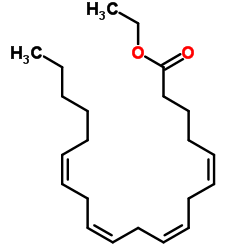Ethyl (5Z,8Z,11Z,14Z)-5,8,11,14-icosatetraenoate

Ethyl (5Z,8Z,11Z,14Z)-5,8,11,14-icosatetraenoate structure
|
Common Name | Ethyl (5Z,8Z,11Z,14Z)-5,8,11,14-icosatetraenoate | ||
|---|---|---|---|---|
| CAS Number | 1808-26-0 | Molecular Weight | 332.520 | |
| Density | 0.9±0.1 g/cm3 | Boiling Point | 418.1±34.0 °C at 760 mmHg | |
| Molecular Formula | C22H36O2 | Melting Point | N/A | |
| MSDS | Chinese USA | Flash Point | 100.7±24.0 °C | |
|
Development of a new immunoassay for the detection of ethyl glucuronide (EtG) in meconium: validation with authentic specimens analyzed using LC-MS/MS. Preliminary results.
Clin. Chem. Lab Med. 52(8) , 1179-85, (2014) Ethyl glucuronide (EtG) measurement in neonatal meconium has emerged as a reliable marker to objectively assess prenatal exposure to maternal ethanol complementary to fatty acid ethyl ester (FAEEs) measurement. The detection of EtG in meconium is currently a ... |
|
|
Kinetic study of the prooxidant effect of alpha-tocopherol. Hydrogen abstraction from lipids by alpha-tocopheroxyl radical.
Lipids 44(10) , 935-43, (2009) A kinetic study of the prooxidant effect of alpha-tocopherol was performed. The rates of allylic hydrogen abstraction from various unsaturated fatty acid esters (ethyl stearate 1, ethyl oleate 2, ethyl linoleate 3, ethyl linolenate 4, and ethyl arachidonate 5... |
|
|
Fatty acid ethyl esters in meconium are associated with poorer neurodevelopmental outcomes to two years of age.
J. Pediatr. 152(6) , 788-92, (2008) To determine the relationship between fatty acid ethyl esters (FAEE) in meconium and neurodevelopment in infants exposed to alcohol in utero at 6.5 months, 1 year, and 2 years of age.A secondary analysis of a prospective cohort of mothers at high risk and the... |
|
|
Ethyl arachidonate is the predominant fatty acid ethyl ester in the brains of alcohol-intoxicated subjects at autopsy.
Lipids 38(3) , 269-73, (2003) The role of fatty acid ethyl esters (FAEE), the nonoxidative ethanol metabolites, as mediators of alcohol-induced organ damage is increasingly being recognized. FAEE are detectable in the blood and in liver and adipose tissue after ethanol ingestion, and on t... |
|
|
Simultaneous determination of acrolein, malonaldehyde and 4-hydroxy-2-nonenal produced from lipids oxidized with Fenton's reagent.
Food Chem. Toxicol. 34(10) , 1009-11, (1996) Ethyl linoleate, ethyl linolenate, ethyl arachidonate and cod liver oil were oxidized with Fenton's reagent. Acrolein, malonaldehyde and 4-hydroxynonenal formed were derivatized to N-methylpyrazoline, N-methylpyrazole and 5-(1'-hydroxyhexyl)-1-methyl-2-pyrazo... |
|
|
Inhibitory effect of 2"-O-glycosyl isovitexin and alpha-tocopherol on genotoxic glyoxal formation in a lipid peroxidation system.
Food Chem. Toxicol. 32(11) , 1047-51, (1994) The inhibitory effect of 2"-O-glycosyl isovitexin (2"-O-GIV), isolated from young barley leaves, on glyoxal formation from the oxidative degradation of three fatty acid ethyl esters was measured. Ethyl linoleate, ethyl linolenate and ethyl arachidonate were o... |
|
|
The improvement in endotoxin-induced redistribution of organ blood flow by inhibition of thromboxane and prostaglandin synthesis.
Adv. Shock Res. 7 , 209-18, (1982)
|
|
|
Inhibitory effects of plant-derived flavonoids and phenolic acids on malonaldehyde formation from ethyl arachidonate.
J. Agric. Food Chem. 51(24) , 7203-7, (2003) The antioxidant activities of naturally occurring plant compounds were measured in a lipid peroxidation system consisting of ethyl arachidonate and Fenton's reagent. Inhibitory effects of 24 plant-derived flavonoids and 5 phenolic acids on malonaldehyde (MA) ... |
|
|
Liver and adipose tissue fatty acid ethyl esters obtained at autopsy are postmortem markers for premortem ethanol intake.
Clin. Chem. 48(1) , 77-83, (2002) Fatty acid ethyl esters (FAEEs) are nonoxidative ethanol metabolites that have been implicated as mediators of alcohol-induced organ damage. FAEEs are detectable in the blood after ethanol ingestion, and on that basis have been proposed as markers of ethanol ... |
|
|
Fatty acid ethyl esters in meconium: are they biomarkers of fetal alcohol exposure and effect?
Alcohol. Clin. Exp. Res. 30(7) , 1152-9, (2006) Biomarkers of fetal exposure to alcohol are important to establish so that early detection and intervention can be made on these infants to prevent undesirable outcomes. The aim of this study was to analyze long-chain fatty acid ethyl esters (FAEEs) in meconi... |